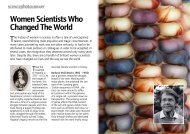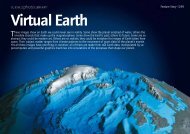Stories - Science Photo Library
Stories - Science Photo Library
Stories - Science Photo Library
- No tags were found...
You also want an ePaper? Increase the reach of your titles
YUMPU automatically turns print PDFs into web optimized ePapers that Google loves.
<strong>Science</strong> <strong>Photo</strong> <strong>Library</strong> Feature <strong>Stories</strong> - Beasts That Time ForgotArgentinean adventurer reported an encounterwith a large, hairy, unknown mammal. In fact, itwas so large that when he shot at it, his bulletsappeared to have no effect.Similar creatures have been described bylocal people over a wide area of Amazonia.They even have a name for it - the Mapinguari.Witnesses tell of a large, sloth-like creaturethat, when startled, rears up on its hind legs,shows its large claws and adopts an aggressivestance - just as Megatherium might have done.This may be rural legend, but villagers in areaswhere theMapinguarihas been reportedtakethe storiesseriouslyenough toavoid the forestat night.At least onezoologistbelieves the‘Mapi’ are,in fact, descendantsorrelatives ofgiant slothslike Megatherium.The averageweightof a malehumanEuropean isabout 80 kilos.The largestprimatethat everlived makeshumans lookpuny. Gigantopithecusweighedin at 500kilos andmeasured3 metres,two to threetimes thesize of today’s gorillas, which it superficiallyresembles. (in fact, its closest living relatives areorangutans). Gigantopithecus roamed southeastAsia for nearly one million years, before dyingout about 100,000 years ago. So it could haveco-existed alongside humans, to whom it wouldhave presented an awesome spectacle. Likegorillas, Gigantopithecus was a herbivore, feastingmainly on bamboo - which may have led toits demise as tropical jungle declined throughclimate change.But Gigantopithecus may not have died outentirely. Some researchers believe it still existsas the legendary primates known in variousplaces as Bigfoot and the Yeti. Whether that istrue or not, Gigantopithecus certainly playedone major role in modern times: its fossils werediscovered in the 1920s, leading to popularfascination - and a place in cultural history asthe basis for King Kong in the 1933 film classic.MammothsOf all the extinct mammals those paths crossedthose of humans, the most well-documentedand popular are the mammoths. We knowthey existed alongside humans - our ancestorspainted them on cave walls, often showingthem being hunted. And complete mammothshave been found beneath the frozen tundra ofSiberia. The mammoths were an extraordinarilysuccessful species. They survived for severalmillion years, and were widespread across theplanet.Mammoth remains have been found inEurope, Africa, Asia and north America. Theirthick coats allowed them to thrive during theIce Ages: their population density in Siberiaalone has been estimated at 60 mammoths toevery 100 square kilometres. Most mammothswere about the same size as today’s Indianelephants. But some were much larger: theImperial Mammoths of California weighed over8 tons and reached heights of over 4 metres.Most mammoths died out at the end of thelast Ice Age, about ten thousand years ago. Nooneknows for sure why they became extinct. Itwas probably a combination of several factors- a warming Earth; hunting by humans; anddisease. Yet some survived into relatively recenttimes. Remains of smaller versions, called ‘dwarfmammoths’, have been found on remote islandsand dated to just 1,500 BC. And, like Gigantopithecus,there are claims that mammoths maystill exist. Reports by Siberian tribesmen suggestthat small groups of them may still exist in thevastness of the tundra.Even if the great mammoths are truly extinct,it may be possible to ‘revive’ them. It’s notbeyond the realms of possibility that scientistscould create an animal similar to the mammoth.Take DNA from a well-preserved male mammothcorpse, recreate its sperm, and use thatto impregnate a female Indian elephant - themammoth’s closest living relative. This wouldbe difficult, to say the least, but some scientistsbelieve it is possible, and far more realisticthan trying to recreate a dinosaur. Just recently,in December 2005, researchers managed tocomplete a section of mammoth DNA called‘mitochondrial DNA’, which is passed down thegenerations via the female line. So re-creatingmammoth sperm may not be as outrageous asit sounds.The early mammals of the Cenezoic - thebeasts that time forgot - had as much animpact on their surroundings as the dinosaursthey replaced. Their cousins - the mammals thatfollowed them - are still the dominant animalson land. And if it were possible to create aCenezoic Park, its inhabitants would be justas bizarre, and fascinating, as the dinosaurs ofJurassic Park.ENDS 2450 WDSWritten by Jon Trux© SCIENCE PHOTO LIBRARY 2006
















